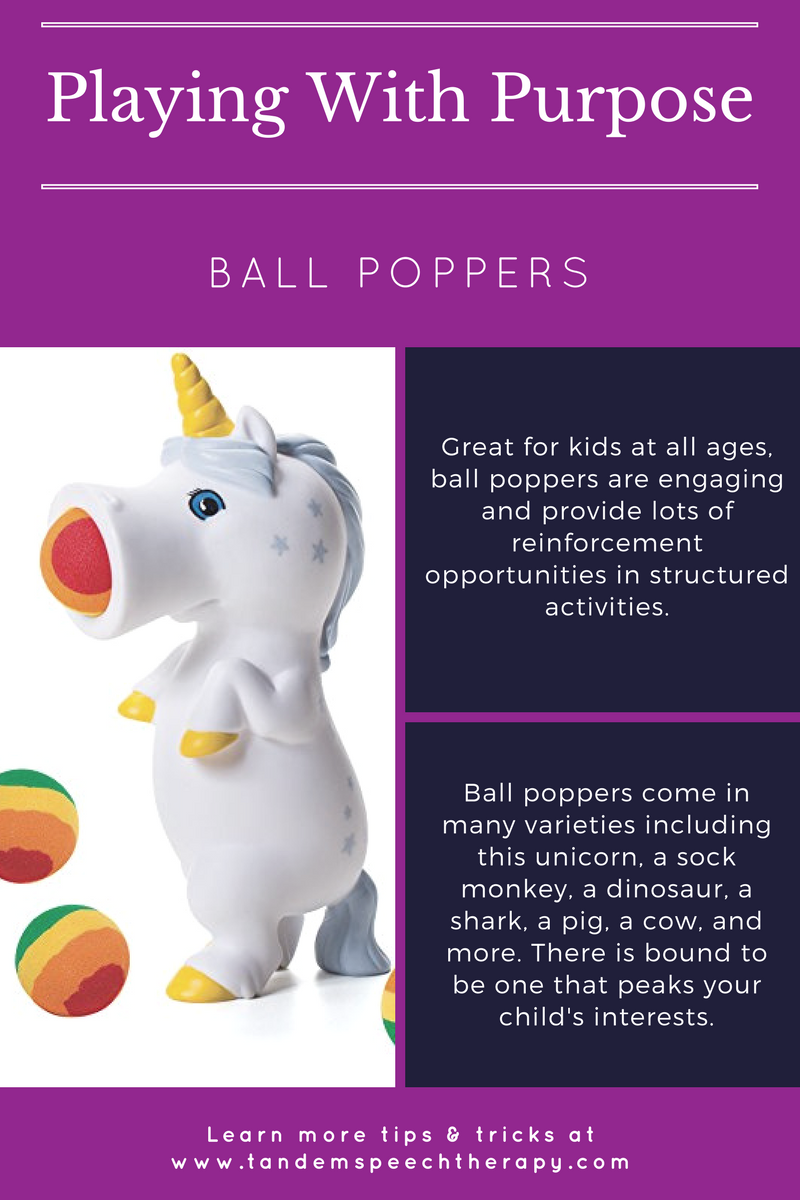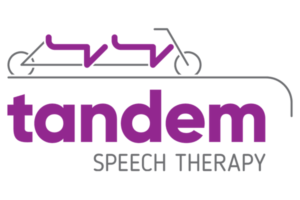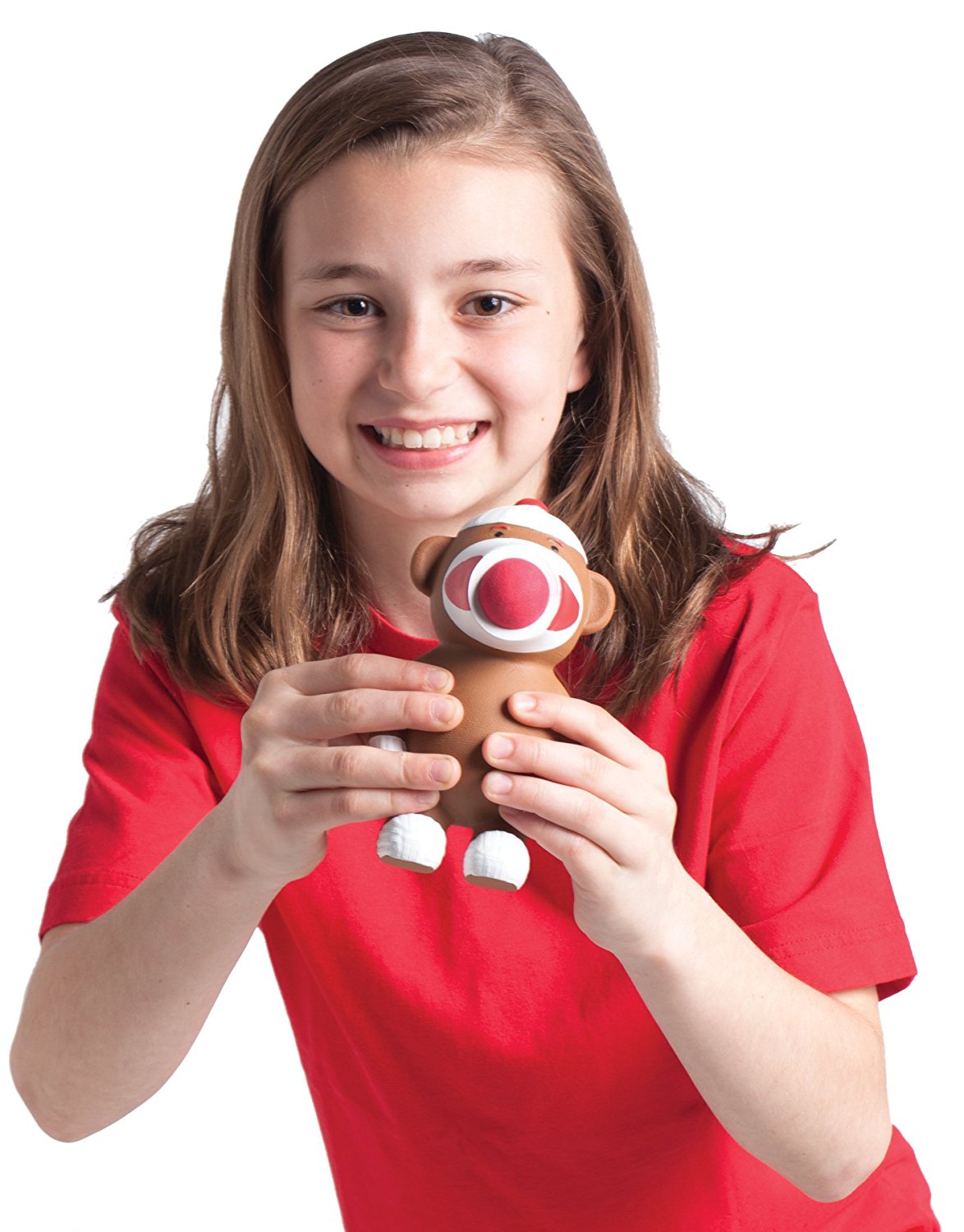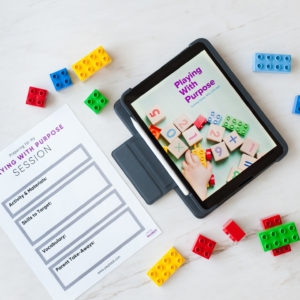Five years ago, while working at a clinic here in Austin, I learned about ball poppers. A fantastic occupational therapist owns the clinic, and she purchased the cow ball popper to work on fine motor skills. I quickly learned that this was not an OT-only toy. I found myself using the ball popper with almost all my patients. No matter how old they were or where they were in speech and language development, I could turn this toy into many speech and language building opportunities.
Ball popper toys are super engaging and reinforcing for children. For those of you unfamiliar with the popper, they are small plastic figures that “pop” out a small ball when you squeeze them. They come in a ton of different character and animal options, so there is bound to be one that peaks your child’s interests. Additionally, they are inexpensive at under $10 each. They can keep kids from preschool-age and up through the elementary years amused and are incredibly small and portable. All winners in my book for this traveling pediatric speech therapist!

Ball popper toys are not only for the older children you have. They are also great for kids as young as 9 months old. Ball poppers for younger kiddos simply look and function a bit differently since you child will not have the fine motor skills to squeeze the popper. When you use a ball popper with your younger child, you can work on: counting, labeling or identifying colors, basic requesting such as asking for “more” or “again”, and simple turn taking for pushing the button to activate the toy.
Another toy that I love, which is similar to a ball popper, is the Elefun Game. It is a fantastic game for early turn taking and categorizing with children aged 3 and up.
Top 5 Tips for Playing With Purpose using a Ball Popper
- Target practice is a fun game to play with a ball popper. I use it with kids who are practicing new speech sounds, but it’s perfect for almost any new skill that requires repetition. Draw a target on a piece of paper and stick it up on any door. I use 2 points in the center, 5 for the middle, and 10 in the outside ring. Then let your child use the ball popper toy to hit the target. Whatever number the ball is closest to dictates how many times your kiddo has to practice their target word or skill. I give families word lists to practice. If your child is a reader, then let them try the words on their own. If not, then provide a model.
- Use the ball popper to practice object naming, vocabulary, and simple requests. A ball popper is an excellent tool for early communicators. It’s amazing how much language you can target with this simple toy. For example, I hold on to the popper toy and work on vocabulary or requesting with words such as “ball,” “pop,” “again,” “my turn,” “squeeze,” and “push.” When working with young children, it’s especially important to reinforce their communication attempts immediately. The balls are the reinforcement. As soon as a child communicates, you should reward him/her (i.e., give a ball or squeeze) and give specific verbal praise. This may sound like, “I love how you asked me for a ball.”
- Incorporate ball poppers into games that teach the skill of following directions. This is similar to the obstacle course idea from my last PWP post. For example, you could say, “Stand up and pop the toy,” which is a 2-step direction. For children working on multi-step directions, I start by placing the balls around the room. Then I give a direction such as, “Pick up the ball under the chair, jump two times, and then shoot the ball at the door.”
- Prepositions or location words are concepts I typically begin teaching around 3-4 years old. Playing with ball poppers intentionally can enhance both expressive (use of words) and receptive (comprehension) language skills. When kids pop the ball, parents can ask questions such as “Where did the ball land?”. Children will then use their preposition words to tell you if the ball landed “next to” the chair, “behind” the sofa, or “under” the table. This is the expressive language task. If you want to work on comprehension or receptive language, then give a direction like, “shoot the ball under the table.” If the ball lands where you directed, then this demonstrates an understanding of the concept “under.”
- I also use ball popper toys as a general reinforcer. My older kids like to earn the balls from the popper when we are working on categories. We start by choosing a category and each time the child names a member of the group, they earn a ball. Naming to categories can be as simple as, “Tell me some farm animals.” Or can be more complex like, “Tell me six foods that are cold.” Working to name six items per category is an appropriate goal for kids aged 4 to 6. Once they gain all of the balls, the popping fun begins.
Start Playing With Purpose
Learn how to purposefully and intentionally interact with your child during play and help them increase opportunities for speech and language development with our Playing with Purpose book!












